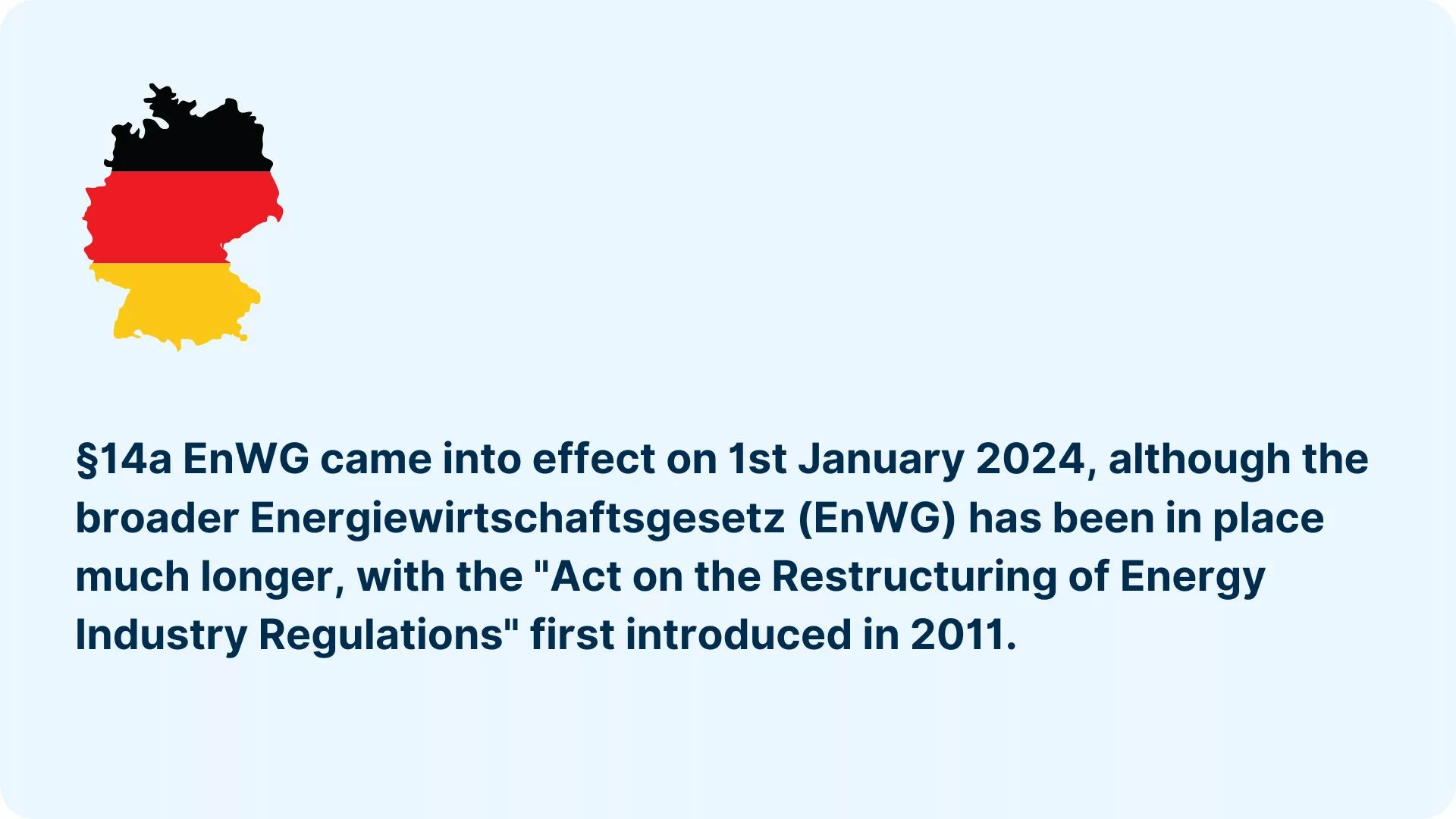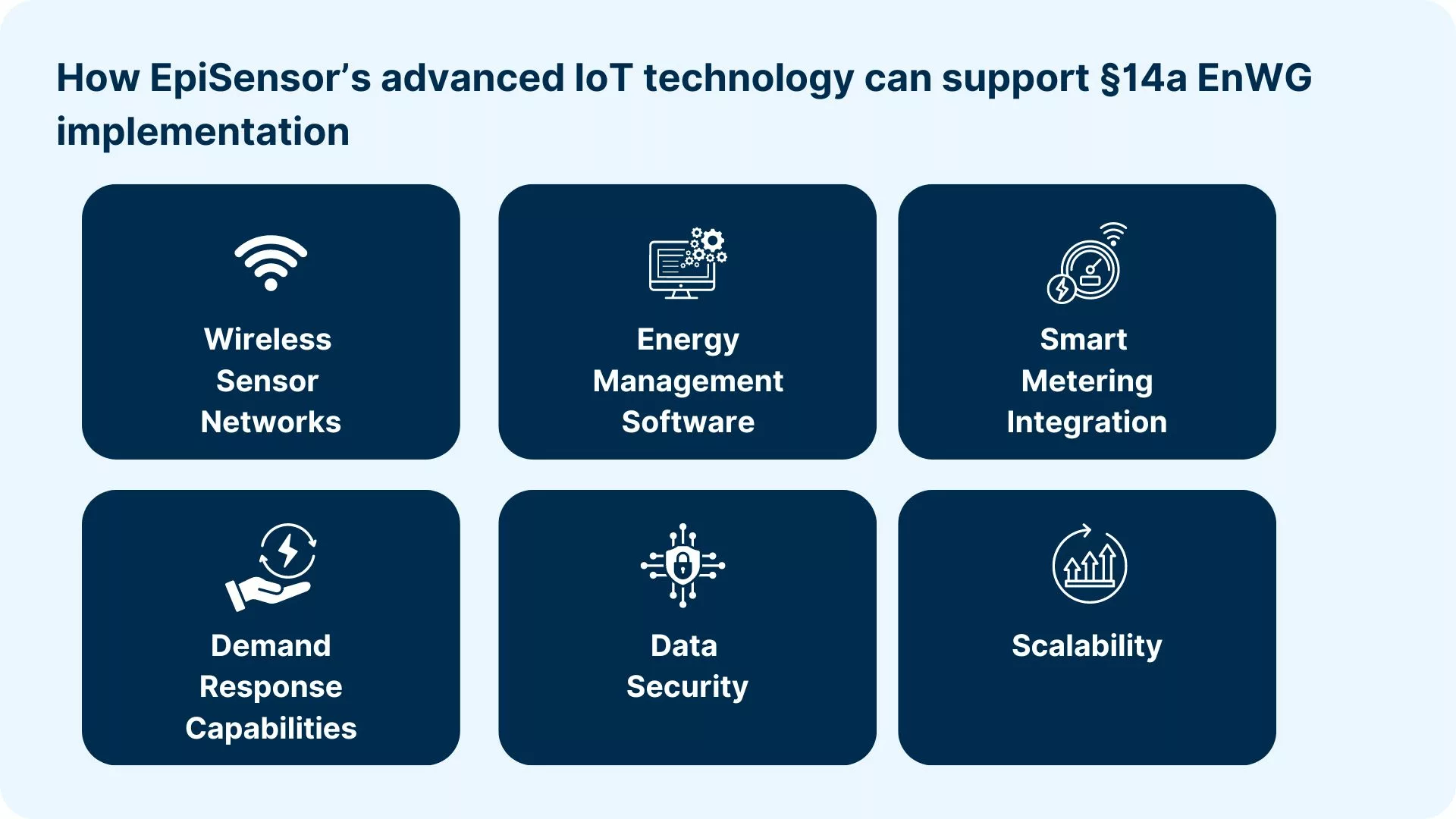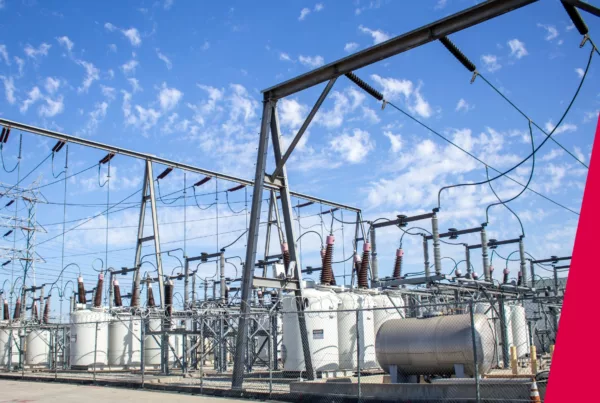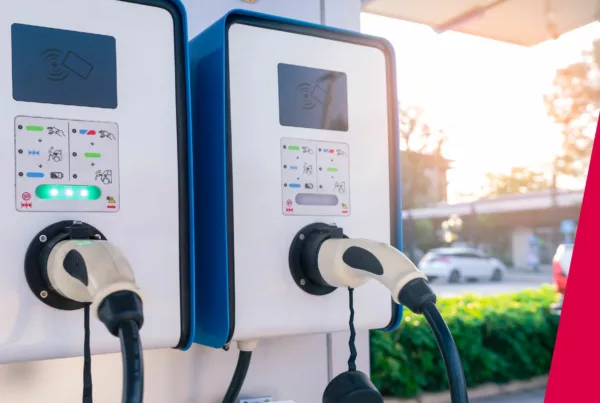About §14a EnWG or Section 14A
As Germany continues to advance its transition to renewable energy, efficient grid management becomes increasingly vital. A key regulatory change supporting this shift is §14a EnWG (Section 14a of the German Energy Industry Act), which focuses on integrating flexible loads into the national electricity grid. The introduction of paragraph 14a enables grid operators in Germany to manage electricity loads during peak periods, while incentivising consumers to participate in revenue-earning demand response initiatives.
In this article, we’ll recap on the essentials of §14a EnWG, its impact on grid operators in Germany, and the role of IoT in driving implementation and compliance.
What is §14a EnWG or Section 14A?
14a EnWG, or Section 14a of the German Energy Industry Act (Energiewirtschaftsgesetz), is a regulation aimed at advancing Germany’s efforts to modernise the grid and accelerate the transition to renewable energy. The regulation focuses on managing flexible loads, such as electric vehicle (EV) charging stations, heat pumps, and other controllable consumption devices.
When did it come into effect?
14a EnWG came into effect on 1st January 2024, although the broader Energiewirtschaftsgesetz (EnWG) has been in place much longer, with the “Act on the Restructuring of Energy Industry Regulations” first introduced in 2011.

Key aspects of §14a EnWG include:
1. Grid operators’ ability to control flexible loads
One of the central components of §14a EnWG is the grid operators’ authority to manage flexible loads. In times of high electricity demand or excess supply from renewable sources like wind and solar, grid operators can adjust consumption patterns by controlling flexible loads. Similarly, grid operators will have the authority to temporarily reduce the output or ‘dim’ controllable energy-consuming assets, such as EV chargers and heat pumps, during potential grid overloads. By giving grid operators this enhanced control, §14a aims to balance supply and demand, preventing grid overloads and making better use of renewable energy.
This system promotes the shift towards a more resilient and adaptable grid, helping to manage fluctuations in renewable generation without the need for costly grid expansions.
2. Incentives for consumers to participate in load management
14a EnWG also encourages consumer participation in load management through financial incentives. By offering reduced tariffs or direct payments, both residential and industrial consumers are motivated to make their electricity usage more flexible. For instance, homeowners might delay their EV charging or heating operations to align with periods of low demand or high renewable generation, while industries could shift energy-intensive processes to off-peak times.
These incentives are crucial in enabling demand response programs that stabilise the grid while also offering consumers a way to reduce energy costs.
3. Requirements for smart metering and communication infrastructure
A key enabler of load control under §14a EnWG is the implementation of advanced smart metering systems. Smart meters and advanced IoT infrastructure enable real-time monitoring of energy usage and provide grid operators with the data they need to manage flexible loads effectively.
The introduction of 14a requires the deployment of smart meters that not only record energy consumption but also communicate with grid operators to facilitate the dynamic adjustment of loads. This represents a fundamental shift towards a more digitised energy system in Germany.
Exploring Smart Grid solutions?
Examine the features and capabilities of EpiSensor’s advanced IoT solutions
4. Data privacy and security considerations
As energy systems become more digitised and reliant on real-time data, ensuring the privacy and security of this data is critical. §14a EnWG includes stringent provisions to protect consumers’ personal and consumption data from unauthorised access or cyber-attacks. The regulations set clear guidelines on how data is stored, transmitted, and used, ensuring compliance with GDPR and other relevant data privacy laws.
These measures assure consumers that their personal/commercial information and energy usage patterns remain secure, encouraging them to participate in demand response programmes.
The benefits and challenges of §14a EnWG
Benefits
- Improved grid stability and reliability,
- Enhanced integration of renewable energy sources,
- Cost savings for consumers participating in the programmes and grid operators,
- Accelerated development and adoption of smart grid technologies, leading to a more digitised, resilient, energy ecosystem in Germany.
Challenges
- There are implementation costs associated with the introduction of new infrastructure and technologies,
- Ensuring consumer privacy and data security will be critical to the success of the programmes,
- Coordinating diverse stakeholders in the energy sector will require additional management,
- Balancing grid needs with consumer convenience is fundamental to this revised model.

How EpiSensor’s advanced IoT technology can support §14a EnWG implementation
EpiSensor’s IoT-based energy monitoring and management solutions can play a crucial role in supporting the implementation of §14a EnWG:
- Wireless Sensor Networks: EpiSensor’s wireless sensors can be deployed to monitor energy consumption and production across various points in the grid, providing real-time data for load management decisions. With GPS time synchronisation and a reaction times of under 80ms, EpiSensor’s award-winning demand response controller is proven to be highly responsive and reliable in critical scenarios.
- Energy Management Software: EpiSensor Edge can integrate data from multiple sources, enabling grid operators to visualise and analyse energy flows, identify flexible loads, and make informed control decisions. With advanced remote monitoring capabilities, EpiSensor Edge is suited to large-scale energy management applications.
- Smart Metering Integration: EpiSensor’s solutions can interface with smart metering systems, facilitating the collection and transmission of consumption data required for §14a EnWG compliance.
- Demand Response Capabilities: The EpiSensor platform can be configured to support automated demand response actions, allowing grid operators to manage flexible loads in accordance with §14a EnWG requirements. Proven in a variety of environments such as large-scale EV charging networks, data centres, and many other high energy-consuming environments, EpiSensor technology is proven to be reliable and robust.
- Data Security: EpiSensor’s robust data encryption and secure communication protocols ensure that sensitive energy consumption data is protected, addressing the privacy concerns associated with §14a EnWG.
Want to learn how EpiSensor can help you meet §14a EnWG requirements?
Schedule a call with our experts today to discuss how our IoT solutions can support your grid management and compliance needs.
Looking Ahead
As Germany continues its energy transition, regulations like §14a EnWG will play an increasingly important role in shaping the future of the electricity grid. The successful implementation of this regulation will require close collaboration between grid operators, energy suppliers, technology providers, and consumers.
By leveraging IoT technologies and advanced energy management solutions, stakeholders can navigate the challenges and capitalise on the opportunities presented by §14a EnWG, contributing to a more flexible, efficient, and sustainable energy system.
Further Reading



